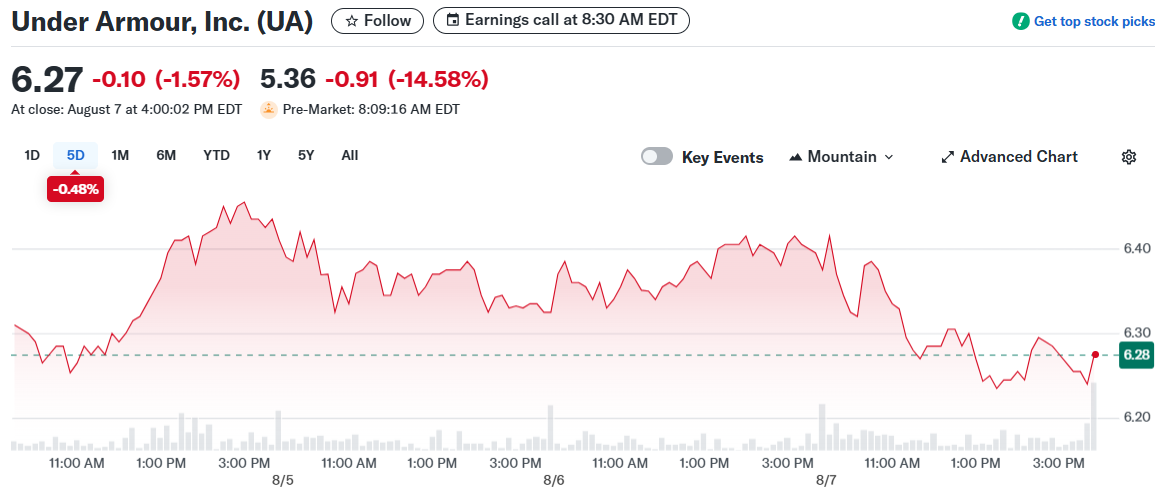TLDR
- Under Armour forecasts second-quarter revenue to decline 6-7%, worse than analyst estimates of 2.9% drop
- Stock dropped 13% in premarket trading following the disappointing revenue outlook
- Company faces tariff pressure with 20% levies on Vietnamese goods and 19% on Indonesian products
- First-quarter revenue fell 4% to $1.13 billion, meeting estimates but showing inventory buildup
- Gross margins expected to decline 340-360 basis points due to tariff-related supply chain issues
Under Armour stock plunged 13% in premarket trading Friday after the athletic apparel company issued a weaker-than-expected revenue forecast for the second quarter. The Maryland-based retailer expects quarterly revenue to decline between 6% and 7%.

Analysts had projected a much smaller 2.9% drop in revenue for the period. The disappointing outlook reflects ongoing challenges from tariff uncertainty and inflationary pressures that continue to weigh on consumer demand.
The company reported first-quarter results that painted a mixed picture. Revenue fell 4% to $1.13 billion, which matched analyst expectations. However, inventory levels rose 2%, suggesting the company is struggling to move products efficiently.
Under Armour, $UA, Q1-26. Results:
📊 Adj. EPS: $0.02 🔴
💰 Revenue: $1.13B 🟢
📈 Net Income: -$2.6M
🔎 Revenue fell 4.2% YoY to $1.134B, with declines in North America and Asia-Pacific, while gross margin improved 70 bps to 48.2%. pic.twitter.com/XVDGseNVUk— EarningsTime (@Earnings_Time) August 8, 2025
Under Armour’s adjusted earnings per share came in at 2 cents for the quarter. This missed analyst estimates of 3 cents per share, adding to investor concerns about the company’s financial performance.
The sportswear maker faces direct exposure to tariff policies that have created uncertainty in its supply chain operations. About 30% of Under Armour’s merchandise volume comes from Vietnam, while 15% originates from Indonesia.
Current tariff structures impose 20% levies on goods from Vietnam and 19% on products from Indonesia. These rates directly impact Under Armour’s cost structure and profit margins.
Tariff Impact on Margins
The company expects gross margins to decline by 340 to 360 basis points in the current quarter due to potential tariff-related supply chain disruptions. Under Armour stated that favorable foreign exchange rates and pricing benefits would only partially offset this decline.
Management cited ongoing uncertainty around trade policies and the broader economic environment as key factors in their revenue projections. The company also mentioned potential impacts of tariffs on both demand patterns and operational costs.
Under Armour announced plans in May to raise prices on its products. This strategy carries additional risk as consumers already face pressure from inflation and may seek cheaper alternatives.
The retailer’s sales have declined over the past two years as management attempts to reset the business strategy. These turnaround efforts now face headwinds from external economic factors beyond the company’s direct control.
Recent Performance Metrics
The stock has declined 13.87% year-to-date, reflecting broader investor concerns about the company’s direction. Average trading volume stands at approximately 2.9 million shares, indicating active investor interest despite the challenges.
Current market capitalization sits at $2.79 billion following the recent share price decline. Technical indicators show a sell signal, suggesting continued pressure on the stock price.
Analysts have reduced price targets for Under Armour shares following these latest financial results. The combination of revenue headwinds and margin pressure has dampened Wall Street’s outlook for the company.
Under Armour continues to work on improving its brand positioning in the competitive athletic apparel market. However, these efforts must now contend with external pressures from trade policies and economic uncertainty.
The company sources significant portions of its merchandise from Southeast Asian countries that face varying tariff rates. This geographic concentration creates vulnerability to policy changes that affect international trade relationships.
Under Armour management emphasized that their revenue forecast incorporates considerations for ongoing trade policy uncertainty and broader economic conditions that could impact consumer behavior and operational costs.
Stay Ahead of the Market with Benzinga Pro!
Want to trade like a pro? Benzinga Pro gives you the edge you need in today's fast-paced markets. Get real-time news, exclusive insights, and powerful tools trusted by professional traders:
- Breaking market-moving stories before they hit mainstream media
- Live audio squawk for hands-free market updates
- Advanced stock scanner to spot promising trades
- Expert trade ideas and on-demand support



